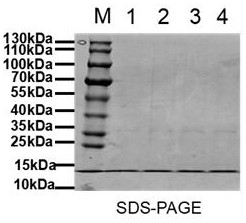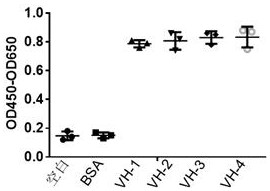Nanobody, encoding gene thereof, expression vector, host cell and application of nanobody
A technology of nano-antibody and coding gene, which is applied in the direction of anti-receptor/cell surface antigen/cell surface determinant immunoglobulin, antibody, application, etc. It can solve the problems of high production cost, large molecular weight, difficulty in rapid and uniform dispersion, etc. question
- Summary
- Abstract
- Description
- Claims
- Application Information
AI Technical Summary
Problems solved by technology
Method used
Image
Examples
Embodiment 1
[0033] This embodiment provides an anti-Siglec-15 nanobody, which is a nanobody directed against a specific extracellular region of Siglec-15, and its amino acid sequence is as SEQ ID NO.8, SEQ ID NO.13, SEQ ID NO.18, As shown in SEQ ID NO.23, the nucleotide sequences encoding them are respectively shown in SEQ ID NO.7, SEQ ID NO.12, SEQ ID NO.17, and SEQ ID NO.22. Specifically, the nucleotide sequences encoding them are composed of 3 framework regions and 3 CDRs, wherein the nucleotide sequences of the 3 framework regions are respectively as SEQ ID NO.1, SEQ ID NO.2 and SEQ ID NO.3 As shown, the nucleotide sequences of the three CDRs are respectively as SEQ ID NO.4, SEQ ID NO.5 and SEQ ID NO.6; SEQ ID NO.9, SEQ ID NO.10 and SEQ ID NO.11; SEQ ID NO. NO.14, shown in SEQ ID NO.15 and SEQ ID NO.16, SEQ ID NO.19, SEQ ID NO.20 and SEQ ID NO.21; the nucleotide sequences of the three framework regions are shown in SEQ ID NO. 24 (corresponding to SEQ ID NO.1), SEQ ID NO.25 (correspon...
Embodiment 2
[0081] This embodiment provides a kind of screening method against Siglec-15 nanobody, it comprises:
[0082] Using the human phage nano-antibody library and using Siglec-15 as the antigen, three rounds of screening were carried out from the antibody library, and each round of screening was carried out according to the steps of adsorption-elution-amplification.
[0083] (1) Amplification of the VH nanobody library: Thaw the frozen phage antibody library on ice, pipette 400 μL into preheated 200 mL of 2×TY, and add 1% Glu and 1% Amp. Cultivate at 37°C, 250 rpm until OD600=0.4. Take 50 mL of bacterial solution and add 2×10 11 KM13 helper phages were incubated in a water bath at 37°C for 30 min. Centrifuge at 3000 g for 10 min to discard the supernatant, resuspend the pellet with 100 mL 2×TY, add 100 μg / mL Amp and 50 μg / mL Kan, and incubate overnight at 30°C and 250 rpm. The next day, the overnight bacterial solution was centrifuged at 3300 g for 30 min, and the precipitate w...
Embodiment 3
[0088] This embodiment provides a method for yeast expression and purification of an anti-Siglec-15 Nanobody, which includes the following steps:
[0089] S1. Three positive clones were sequenced and analyzed, cloned into pPICzαA yeast expression plasmid, and transformed into Pichia pastoris GS115 for soluble expression. The nucleotide and amino acid sequences are respectively SEQ ID: NO.7 and SEQ ID: NO.8; SEQ ID NO.12 and SEQ ID: NO.13; SEQ ID: NO.17 and SEQ ID: NO.18; NO .22 and SEQ ID: NO.23.
[0090] S2. Extract the PIT2-Siglec-15-VH recombinant plasmid and the pPICZα A plasmid respectively, use PIT2-Siglec-15-VH as a template PCR, carry out the amplification of the target fragment VH, use restriction endonucleases to carry out double enzyme digestion, gel After recovering the target fragment and the enzyme-digested vector, use T4 DNA ligase to connect the target gene fragment and the vector. Ethanol precipitated DNA; linearized electrotransformation of 5-20 µg of DNA i...
PUM
 Login to View More
Login to View More Abstract
Description
Claims
Application Information
 Login to View More
Login to View More - R&D Engineer
- R&D Manager
- IP Professional
- Industry Leading Data Capabilities
- Powerful AI technology
- Patent DNA Extraction
Browse by: Latest US Patents, China's latest patents, Technical Efficacy Thesaurus, Application Domain, Technology Topic, Popular Technical Reports.
© 2024 PatSnap. All rights reserved.Legal|Privacy policy|Modern Slavery Act Transparency Statement|Sitemap|About US| Contact US: help@patsnap.com










